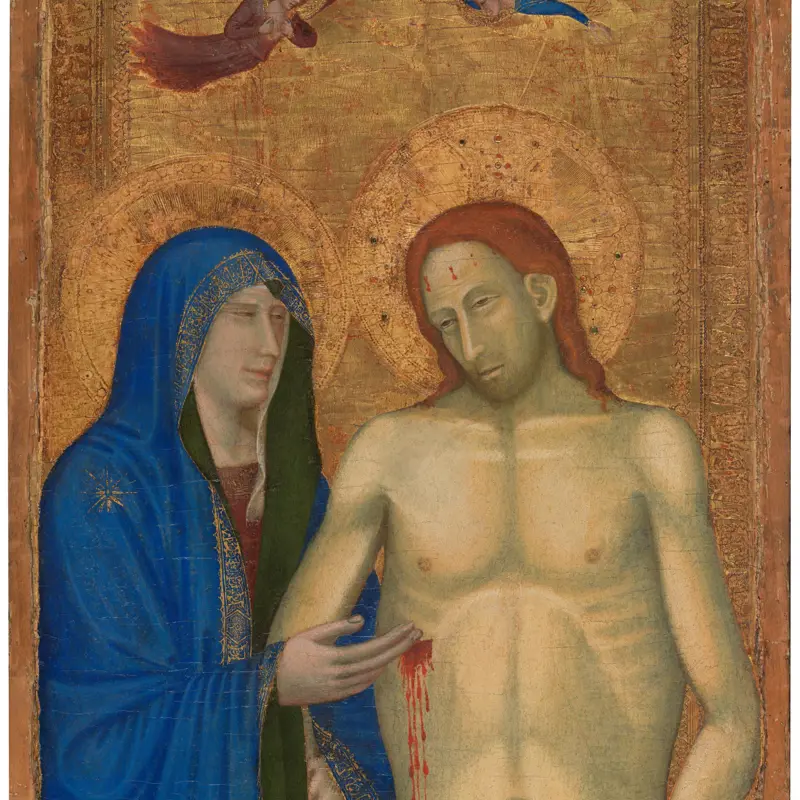Giotto and Workshop, 'Pentecost', probably about 1310-18
About the work
Overview
This small painting of the Pentecost shows Giotto’s skill at transforming complex biblical stories into images that were easy to decipher. Jesus’s followers were gathered together 50 days after his Crucifixion to celebrate the Jewish Feast of Weeks. A strong wind began to blow and flames like ‘tongues of fire’ appeared on their heads. They were filled with the Holy Ghost and began to speak miraculously in a number of languages. A white dove radiating gilded rays, representing the Holy Ghost, has appeared directly beneath the central gable.
Giotto solved the problem of illustrating the narrative clearly by using a low wall to divide those experiencing the event and those straining to hear what was going on. The symmetrical arrangement of the figures focuses our attention on the dove. This picture was the final scene in a horizontal dossal – an altarpiece that was placed in front of rather than above an altar – depicting the life and Passion of Christ.
Key facts
Details
- Full title
- Pentecost
- Artist
- Giotto and Workshop
- Artist dates
- about 1267 or 1276; died 1337
- Date made
- probably about 1310-18
- Medium and support
- egg tempera on wood
- Dimensions
- 45.5 × 44 cm
- Acquisition credit
- Bequeathed by Geraldine Emily Coningham in memory of her husband, Major Henry Coningham, and of Mrs Coningham of Brighton, 1942
- Inventory number
- NG5360
- Location
- Room 65
- Collection
- Main Collection
- Previous owners
- Frame
- 21st-century Replica Frame
Provenance
Additional information
Text extracted from the ‘Provenance’ section of the catalogue entry in Dillian Gordon, ‘National Gallery Catalogues: The Italian Paintings before 1400’, London 2011; for further information, see the full catalogue entry.
Exhibition history
-
2012Florence at the Dawn of the Renaissance: Painting and Illumination, 1300 - 1350The Getty Center Los Angeles13 November 2012 - 10 February 2013Art Gallery of Ontario16 March 2013 - 16 June 2013
-
2017Pietro Lorenzetti: Siena to Hull, a Masterpiece RevealedFerens Art Gallery9 January 2017 - 23 April 2017
-
2017Giovanni da Rimini: A 14th-century Masterpiece UnveiledThe National Gallery (London)14 June 2017 - 8 October 2017
-
2021The Director's Choice: Lizards, Fancy Feathered Hats and TrickeryThe National Gallery (London)5 May 2021 - 9999
Bibliography
-
1951Davies, Martin, National Gallery Catalogues: The Earlier Italian Schools, London 1951
-
1952R. Longhi, 'Presenza di Masaccio nel trittico della Neve', Paragone, XXV, 1952, pp. 8-16
-
1957R. Oertel, Kurzes Verzeichnis der Bilder, Alte Pinakothek, München, ed. E. Buchner, Munich 1957
-
1957F. Zeri, 'Due appunti su Giotto', Paragone, LXXXV, 1957
-
1958C. Gnudi, Giotto, Milan 1958
-
1961M. Davies, The Earlier Italian Schools, 2nd edn, London 1961
-
1962R. Salvini, Tutta la pittura di Giotto, Milan 1962
-
1963B. Berenson, Italian Pictures of the Renaissance: A List of the Principal Artists and Their Work, with an Index of Places: Florentine School, 2 vols, New York 1963
-
1967G. Previtali, Giotto e la sua bottega, Milan 1967
-
1969F. Bologna, I pittori alla corte Angioina di Napoli, 1266-1414, Rome 1969
-
1969F. Bologna, Novità su Giotto: Giotto al tempo della cappella Peruzzi, Turin 1969
-
1969L. Vertova, 'I Tatti', Antichità viva, VIII, 1969, pp. 53-78
-
1978E. Fahy, 'Italian Paintings at Fenway Court and Elsewhere', The Connoisseur, CXCVIII, 1978, pp. 28-9
-
1982K. Christiansen, 'Fourteenth-Century Italian Altarpieces', Metropolitan Museum of Art Bulletin, XL/1, 1982, pp. 53-5
-
1982D. Gordon, 'A Perugian Provenance for the Franciscan Double-Sided Altar-Piece by the Maestro di San Francesco', The Burlington Magazine, CXXIV/947, 1982, pp. 70-7
-
1985National Gallery, 'Pictures Cleaned and Restored in the Conservation Department of the National Gallery, January 1984 - December 1984', National Gallery Technical Bulletin, IX, 1985
-
1986Davies, Martin, National Gallery Catalogues: The Earlier Italian Schools, revised edn, London 1986
-
1986G. Bonsanti, Giotto: Historical Notes and Critical Appraisals, Padua 1986
-
1988Gordon, Dillian, National Gallery Catalogues: The Early Italian Schools before 1400, revised edn, London 1988
-
1989S.B. Bistoletti, Giotto: Catalogo complete dei dipinti, Florence 1989
-
1989D. Gordon, 'A Dossal by Giotto and His Workshop: Some Problems of Attribution, Provenance and Meaning', The Burlington Magazine, CXXXI/1037, 1989, pp. 524-31
-
1989D. Bomford et al., Italian Painting before 1400 (exh. cat. The National Gallery, 29 November 1989 - 28 February 1990), London 1989
-
1991J. Dunkerton et al., Giotto to Dürer: Early Renaissance Painting in the National Gallery, New Haven 1991
-
1991F. Haskell, 'William Coningham and His Collection of Old Masters', The Burlington Magazine, CXXXIII/1063, 1991, pp. 676-81
-
1993A. Busignani, Giotto, Florence 1993
-
1994E. Langmuir, The National Gallery Companion Guide, London 1994
-
1994A. Thomas, An Illustrated Dictionary of Narrative Painting, London 1994
-
1995F. Flores D'Arcais, Giotto, trans. R. Rosenthal, London 1995
-
2001
C. Baker and T. Henry, The National Gallery: Complete Illustrated Catalogue, London 2001
-
2011Gordon, Dillian, National Gallery Catalogues: The Italian Paintings before 1400, London 2011
Frame
This replica frame was made at the Gallery in 2016. Meticulously copied from the fourteenth-century frame around Giotto’s Crucifixion at the Musée des Beaux-Arts in Strasbourg, the moulding was crafted in poplar wood and the water gilding has an antique effect. The frame moulding features a fillet top edge, an inset cavetto and a slight ogee with a slanted edge at the sight edge.
Pentecost was one of seven paintings adorning a large plank of wood, forming part of a rectangular altarpiece, which was later separated into individual images. Notably, this Giotto panel retains residue of the burr edge on its right-hand side, indicative of the former engaged frame being forcibly removed.
About this record
If you know more about this work or have spotted an error, please contact us. Please note that exhibition histories are listed from 2009 onwards. Bibliographies may not be complete; more comprehensive information is available in the National Gallery Library.

